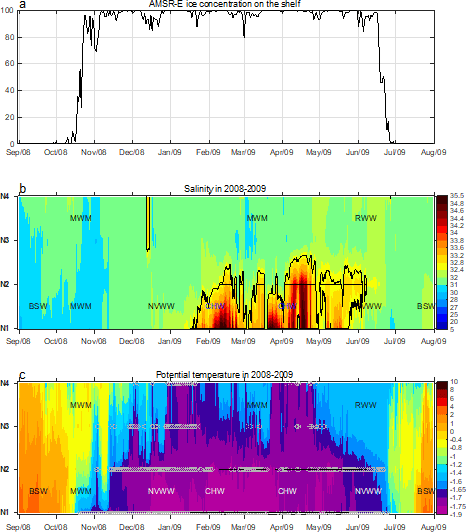Lin, P., Pickart, R. S., Weingartner, T. J., Simmons, H. L., Itoh, M., & Kikuchi, T., 2023. Formation and circulation of newly ventilated winter water in the western Beaufort Sea. Progress in Oceanography, 216, 103068. https://doi.org/10.1016/j.pocean.2023.103068
Newly ventilated winter water (NVWW) is a cold, salty, nutrient-rich water mass that is critical for supporting the ecosystem of the western Arctic Ocean. In this study, NVWW formation is documented using timeseries from an 8-mooring array deployed from 2008 to 2009 across the shelf and slope in the western Beaufort Sea near 150°W. The saltiest (densest) class of the winter water (salinity > 32.6), which is able to ventilate the cold halocline in the interior Canada Basin, was only observed on the inner shelf (moorings N1 and N2 in the figure above) from December to May. The reasons for this are three-fold: (1) In mid- to late-fall the water on the outer shelf (moorings N3 and N4 in the figure above) is largely influenced by fresher water in the vicinity of the shelfbreak, limiting the density of the winter product there; (2) during winter the variance in ice cover is significantly higher on the inner shelf than the outer shelf, and this enhanced presence of leads and polynyas results in more re-freezing and hence formation of saltier winter water; and (3) the cross-shelf velocities during the cold months (December–May) were negligible at the array site. It is argued that the salty NVWW can be fluxed off the shelf due to the convergence of the westward-flowing current on the shelf and the eastward-flowing outflow from Barrow Canyon. (Summary and image provided by Peigen Lin)

